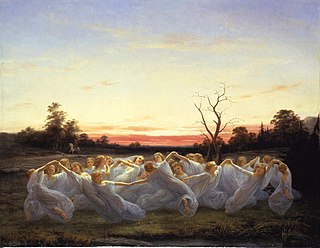"Du gamla, du fria" is the de facto national anthem of Sweden. It was originally named "Sång till Norden", but the incipit has since been adopted as the title.

Fjölsvinnsmál or The Sayings of Fjölsvinnr is the second of two Old Norse poems commonly published under the title Svipdagsmál "The Lay of Svipdagr". These poems are found together in several 17th-century paper manuscripts with Fjölsvinnsmál. In at least three of these manuscripts, the poems appear in reverse order and are separated by a third eddic poem titled Hyndluljóð. For a long time, the connection between the two poems was not realized, until in 1854 Svend Grundtvig pointed out a connection between the story told in Gróagaldr and the first part of the medieval Scandinavian ballad of Ungen Sveidal/Herr Svedendal/Hertig Silfverdal. Then in 1856, Sophus Bugge noticed that the last part of the ballad corresponded to Fjölsvinnsmál. Bugge wrote about this connection in Forhandlinger i Videnskabs-Selskabet i Christiania 1860, calling the two poems together Svipdagsmál. Subsequent scholars have accepted this title.

Kvæði are the old ballads of the Faroe Islands, accompanied by the Faroese dance. Kvæði can have hundreds of stanzas plus a chorus sung between every verse.
"Clerk Colvill" is Child ballad 42.
"Gil Brenton" is Child ballad 5, Roud 22, existing in several variants.

"Stolt Herr Alf" or "Álvur kongur" is a medieval Scandinavian ballad with Swedish and Faroese variants which, because of its content, is thought to originate from pre-Christian times. There are two different manuscripts of this ballad in the National Library of Sweden, and some dialectal words indicate that the ballad was current in south-western Sweden before its documentation.

"Töres döttrar i Wänge" or "Per Tyrssons döttrar i Vänge" is a medieval Swedish ballad on which Ingmar Bergman's The Virgin Spring is based. The ballad type is found throughout Scandinavia, with variants in Danish, Faroese, Icelandic, and Norwegian. The Child Ballad "Babylon" is analogous to the Scandinavian songs.
James Rhea Massengale is an American musicologist and former professor at UCLA, who has specialised in the Swedish poets Carl Michael Bellman and Olof von Dalin. He is a member of the Royal Swedish Academy of Music. He was educated at Yale University, Cambridge University, and Harvard University. He was a professor at UCLA from 1970 to his retirement in 2006.
Elvehøj is the Danish name of a Scandinavian ballad, known in Swedish as Älvefärd, type A 65 in The Types of the Scandinavian Medieval Ballad; it is also attested in Norwegian.
"Elveskud" or "Elverskud" is the Danish, and most widely used, name for one of the most popular ballads in Scandinavia.
Herr Magnus og bjærgtrolden is a Danish ballad.
Herr Tønne af Alsø is a Danish ballad. Danmarks gamle Folkeviser records two versions: A and B (38); it also appears in Norway and Sweden. Dokumentasjonsprosjektet in Norway notes eight different variants, one dating back to the 1840s.
Agnete og Havmanden (Danish) or Agneta och havsmannen (Swedish) is a ballad. It is also found in Norway and as a prose folktale published by Just Matthias Thiele in his 1818 Danske Folkesagn, though Thomas Bredsdorff has argued that this prose version is of literary rather than folkloric origin. The ballad too is generally thought to be relatively late in its composition, perhaps from the eighteenth century.
Trolden og Bondens Hustru is a Danish ballad.

Hilda Augusta Amanda Kerfstedt, née Hallström, was a Swedish novelist, playwright and translator. She was a popular and noted writer in late 19th and early 20th century Sweden, and participated in the public debate. She was also engaged in the movement for women's rights, and active in the Fredrika-Bremer-Förbundet and Föreningen för gift kvinnas äganderätt. As a feminist, she focused on the debate around sexual equality, and was critical to the contemporary sexual double standards for men and women. As such, she was one of the participants in the Sedlighetsdebatten, the public debate in Swedish papers, books and plays, which took place during the 1880s. She was the editor of the feminist paper Dagny, the organ of the Fredrika-Bremer-Förbundet, in 1888-1891. She was especially noted within the debate on children's literature.
Føroya kvæði: Corpus Carminum Færoensium (CCF) is a scholarly edition collecting traditional Faroese ballads, or kvæði.
Svenska fornsånger is a three-volume collection of Swedish folk songs compiled by Adolf Ivar Arwidsson and published in 1834, 1837, and 1842, respectively. The first two volumes consist mainly of folk ballads, while the third contains mainly singing games.









